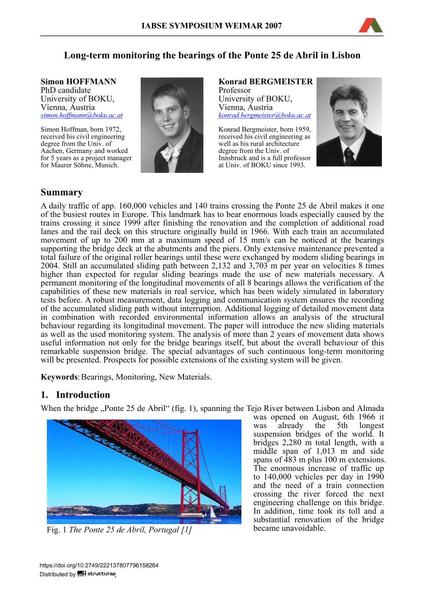Long-term monitoring the bearings of the Ponte 25 de Abril in Lisbon

|
|
|||||||||||
Détails bibliographiques
| Auteur(s): |
Simon Hoffmann
Konrad Bergmeister |
||||
|---|---|---|---|---|---|
| Médium: | papier de conférence | ||||
| Langue(s): | anglais | ||||
| Conférence: | IABSE Symposium: Improving Infrastructure Worldwide, Weimar, Germany, 19-21 September 2007 | ||||
| Publié dans: | IABSE Symposium Weimar 2007 | ||||
|
|||||
| Page(s): | 358-359 | ||||
| Nombre total de pages (du PDF): | 8 | ||||
| Année: | 2007 | ||||
| DOI: | 10.2749/222137807796158264 | ||||
| Abstrait: |
A daily traffic of app. 160,000 vehicles and 140 trains crossing the Ponte 25 de Abril makes it one of the busiest routes in Europe. This landmark has to bear enormous loads especially caused by the trains crossing it since 1999 after finishing the renovation and the completion of additional road lanes and the rail deck on this structure originally build in 1966. With each train an accumulated movement of up to 200 mm at a maximum speed of 15 mm/s can be noticed at the bearings supporting the bridge deck at the abutments and the piers. Only extensive maintenance prevented a total failure of the original roller bearings until these were exchanged by modern sliding bearings in 2004. Still an accumulated sliding path between 2,132 and 3,703 m per year on velocities 8 times higher than expected for regular sliding bearings made the use of new materials necessary. A permanent monitoring of the longitudinal movements of all 8 bearings allows the verification of the capabilities of these new materials in real service, which has been widely simulated in laboratory tests before. A robust measurement, data logging and communication system ensures the recording of the accumulated sliding path without interruption. Additional logging of detailed movement data in combination with recorded environmental information allows an analysis of the structural behaviour regarding its longitudinal movement. The paper will introduce the new sliding materials as well as the used monitoring system. The analysis of more than 2 years of movement data shows useful information not only for the bridge bearings itself, but about the overall behaviour of this remarkable suspension bridge. The special advantages of such continuous long-term monitoring will be presented. Prospects for possible extensions of the existing system will be given. |
||||
| Mots-clé: |
appareils d'appui nouveau matériau
|
||||
